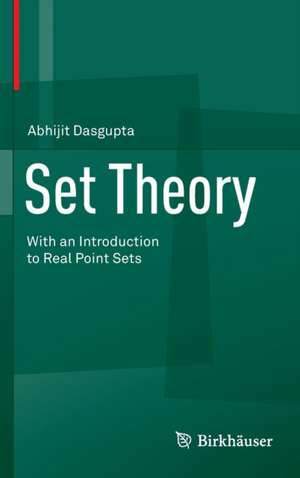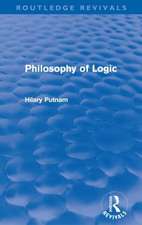Set Theory: With an Introduction to Real Point Sets
Autor Abhijit Dasguptaen Limba Engleză Hardback – 7 dec 2013
To allow flexibility of topic selection in courses, the book is organized into four relatively independent parts with distinct mathematical flavors. Part I begins with the Dedekind–Peano axioms and ends with the construction of the real numbers. The core Cantor–Dedekind theory of cardinals, orders, and ordinals appears in Part II. Part III focuses on the real continuum. Finally, foundational issues and formal axioms are introduced in Part IV. Each part ends with a postscript chapter discussing topics beyond the scope of the main text, ranging from philosophical remarks to glimpses into landmark results of modern set theory such as the resolution of Lusin's problems on projective sets using determinacy of infinite games and large cardinals.
Separating the metamathematical issues into an optional fourth part at the end makes this textbook suitable for students interested in any field of mathematics, not just for those planning to specialize in logic or foundations. There is enough material in the text for a year-long course at the upper-undergraduate level. For shorter one-semester or one-quarter courses, a variety of arrangements of topics are possible. The book will be a useful resource for both experts working in a relevant or adjacent area and beginners wanting to learn set theory via self-study.
Preț: 474.33 lei
Preț vechi: 585.59 lei
-19% Nou
Puncte Express: 711
Preț estimativ în valută:
90.76€ • 94.76$ • 75.12£
90.76€ • 94.76$ • 75.12£
Carte tipărită la comandă
Livrare economică 31 martie-07 aprilie
Preluare comenzi: 021 569.72.76
Specificații
ISBN-13: 9781461488538
ISBN-10: 1461488532
Pagini: 460
Ilustrații: XV, 444 p. 17 illus.
Dimensiuni: 155 x 235 x 30 mm
Greutate: 0.82 kg
Ediția:2014
Editura: Springer
Colecția Birkhäuser
Locul publicării:New York, NY, United States
ISBN-10: 1461488532
Pagini: 460
Ilustrații: XV, 444 p. 17 illus.
Dimensiuni: 155 x 235 x 30 mm
Greutate: 0.82 kg
Ediția:2014
Editura: Springer
Colecția Birkhäuser
Locul publicării:New York, NY, United States
Public țintă
Upper undergraduateCuprins
1 Preliminaries: Sets, Relations, and Functions.- Part I Dedekind: Numbers.- 2 The Dedekind–Peano Axioms.- 3 Dedekind’s Theory of the Continuum.- 4 Postscript I: What Exactly Are the Natural Numbers?.- Part II Cantor: Cardinals, Order, and Ordinals.- 5 Cardinals: Finite, Countable, and Uncountable.- 6 Cardinal Arithmetic and the Cantor Set.- 7 Orders and Order Types.- 8 Dense and Complete Orders.- 9 Well-Orders and Ordinals.- 10 Alephs, Cofinality, and the Axiom of Choice.- 11 Posets, Zorn’s Lemma, Ranks, and Trees.- 12 Postscript II: Infinitary Combinatorics.- Part III Real Point Sets.- 13 Interval Trees and Generalized Cantor Sets.- 14 Real Sets and Functions.- 15 The Heine–Borel and Baire Category Theorems.- 16 Cantor–Bendixson Analysis of Countable Closed Sets.- 17 Brouwer’s Theorem and Sierpinski’s Theorem.- 18 Borel and Analytic Sets.- 19 Postscript III: Measurability and Projective Sets.- Part IV Paradoxes and Axioms.- 20 Paradoxes and Resolutions.- 21 Zermelo–Fraenkel System and von Neumann Ordinals.- 22 Postscript IV: Landmarks of Modern Set Theory.- Appendices.- A Proofs of Uncountability of the Reals.- B Existence of Lebesgue Measure.- C List of ZF Axioms.- References.- List of Symbols and Notations.- Index.
Recenzii
From the book reviews:
“This book is an excellent introduction to set theory. Dasgupta (Univ. of Detroit Mercy) promotes reader/student interaction by integrating problems throughout the text instead of just providing occasional exercise sets. … The book contains more than 630 frequently challenging exercises that will interest both upper-division students and readers with strong mathematical backgrounds. Summing Up: Highly Recommended. Upper-division undergraduates and above.” (D. P. Turner, Choice, Vol. 52 (6), February, 2015)
“This undergraduate textbook provides a thorough examination of the cardinals, ordinals, and the continuum. … This work is a good introduction and would serve for two semesters of upper undergraduate study. … Each part ends with remarks that are a departure point for further exploration. … The author’s clear interest in the subject matter and economy of presentation makes this an effective tool for learning set theory in the lecture hall or through self-study.” (Tom Schulte, MAA Reviews, November, 2014)
“The present undergraduate textbook develops the core material on cardinals, ordinals, and the real line ℝ in an informal, predominantly intuitive but nevertheless concrete and rigorous manner. … this lucidly written undergraduate set theory textbook is a welcome addition to the relevant literature, with many individual features and a remarkably high degree of thematic versatility.” (Werner Kleinert, zbMATH, Vol. 1286 (2), 2014)
“This book is an excellent introduction to set theory. Dasgupta (Univ. of Detroit Mercy) promotes reader/student interaction by integrating problems throughout the text instead of just providing occasional exercise sets. … The book contains more than 630 frequently challenging exercises that will interest both upper-division students and readers with strong mathematical backgrounds. Summing Up: Highly Recommended. Upper-division undergraduates and above.” (D. P. Turner, Choice, Vol. 52 (6), February, 2015)
“This undergraduate textbook provides a thorough examination of the cardinals, ordinals, and the continuum. … This work is a good introduction and would serve for two semesters of upper undergraduate study. … Each part ends with remarks that are a departure point for further exploration. … The author’s clear interest in the subject matter and economy of presentation makes this an effective tool for learning set theory in the lecture hall or through self-study.” (Tom Schulte, MAA Reviews, November, 2014)
“The present undergraduate textbook develops the core material on cardinals, ordinals, and the real line ℝ in an informal, predominantly intuitive but nevertheless concrete and rigorous manner. … this lucidly written undergraduate set theory textbook is a welcome addition to the relevant literature, with many individual features and a remarkably high degree of thematic versatility.” (Werner Kleinert, zbMATH, Vol. 1286 (2), 2014)
Textul de pe ultima copertă
What is a number? What is infinity? What is continuity? What is order? Answers to these fundamental questions obtained by late nineteenth-century mathematicians such as Dedekind and Cantor gave birth to set theory. This textbook presents classical set theory in an intuitive but concrete manner.
To allow flexibility of topic selection in courses, the book is organized into four relatively independent parts with distinct mathematical flavors. Part I begins with the Dedekind–Peano axioms and ends with the construction of the real numbers. The core Cantor–Dedekind theory of cardinals, orders, and ordinals appears in Part II. Part III focuses on the real continuum. Finally, foundational issues and formal axioms are introduced in Part IV. Each part ends with a postscript chapter discussing topics beyond the scope of the main text, ranging from philosophical remarks to glimpses into landmark results of modern set theory such as the resolution of Lusin's problems on projective sets using determinacy of infinite games and large cardinals.
Separating the metamathematical issues into an optional fourth part at the end makes this textbook suitable for students interested in any field of mathematics, not just for those planning to specialize in logic or foundations. There is enough material in the text for a year-long course at the upper-undergraduate level. For shorter one-semester or one-quarter courses, a variety of arrangements of topics are possible. The book will be a useful resource for both experts working in a relevant or adjacent area and beginners wanting to learn set theory via self-study.
To allow flexibility of topic selection in courses, the book is organized into four relatively independent parts with distinct mathematical flavors. Part I begins with the Dedekind–Peano axioms and ends with the construction of the real numbers. The core Cantor–Dedekind theory of cardinals, orders, and ordinals appears in Part II. Part III focuses on the real continuum. Finally, foundational issues and formal axioms are introduced in Part IV. Each part ends with a postscript chapter discussing topics beyond the scope of the main text, ranging from philosophical remarks to glimpses into landmark results of modern set theory such as the resolution of Lusin's problems on projective sets using determinacy of infinite games and large cardinals.
Separating the metamathematical issues into an optional fourth part at the end makes this textbook suitable for students interested in any field of mathematics, not just for those planning to specialize in logic or foundations. There is enough material in the text for a year-long course at the upper-undergraduate level. For shorter one-semester or one-quarter courses, a variety of arrangements of topics are possible. The book will be a useful resource for both experts working in a relevant or adjacent area and beginners wanting to learn set theory via self-study.
Caracteristici
Provides essential set-theoretic prerequisites for graduate work Preserves a classical flavor by incorporating historical threads Includes many examples of the use of set theory in topology, analysis, and algebra Features flexible organization allowing a variety of topical arrangements in various courses Provides extensive problem sets for practice and challenge, many of which are designed for student participation in the development of the main material Includes supplementary material: sn.pub/extras










